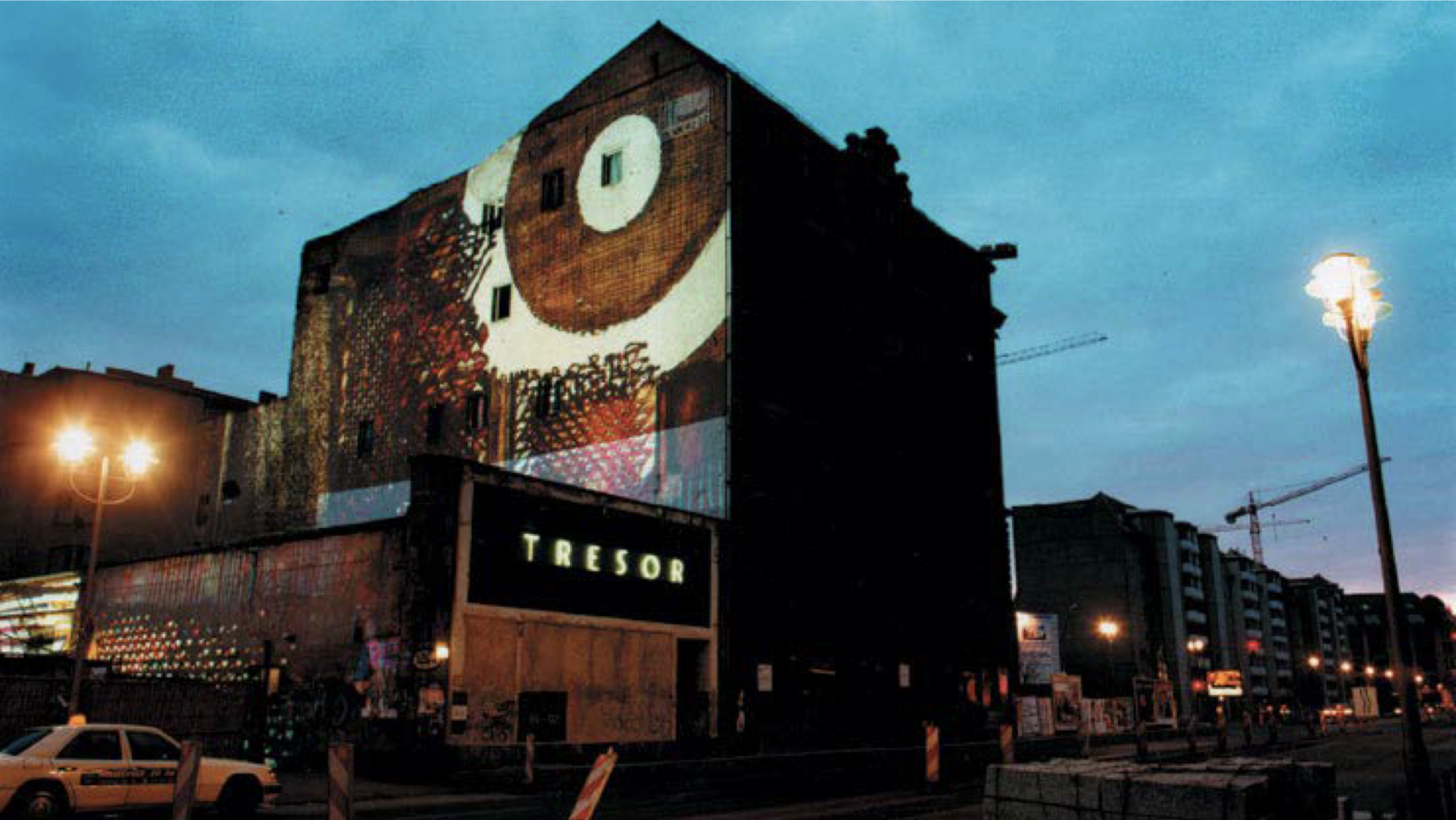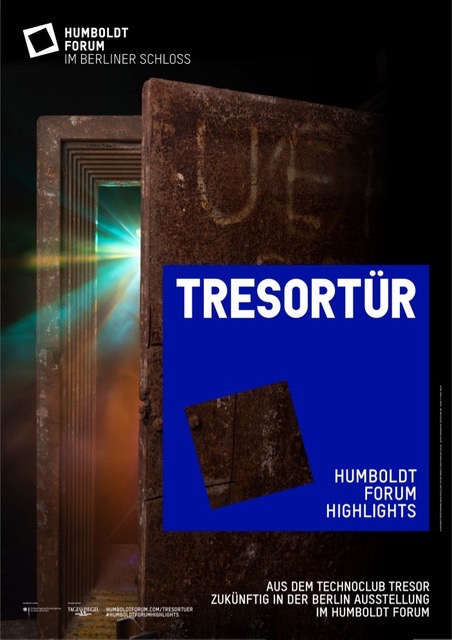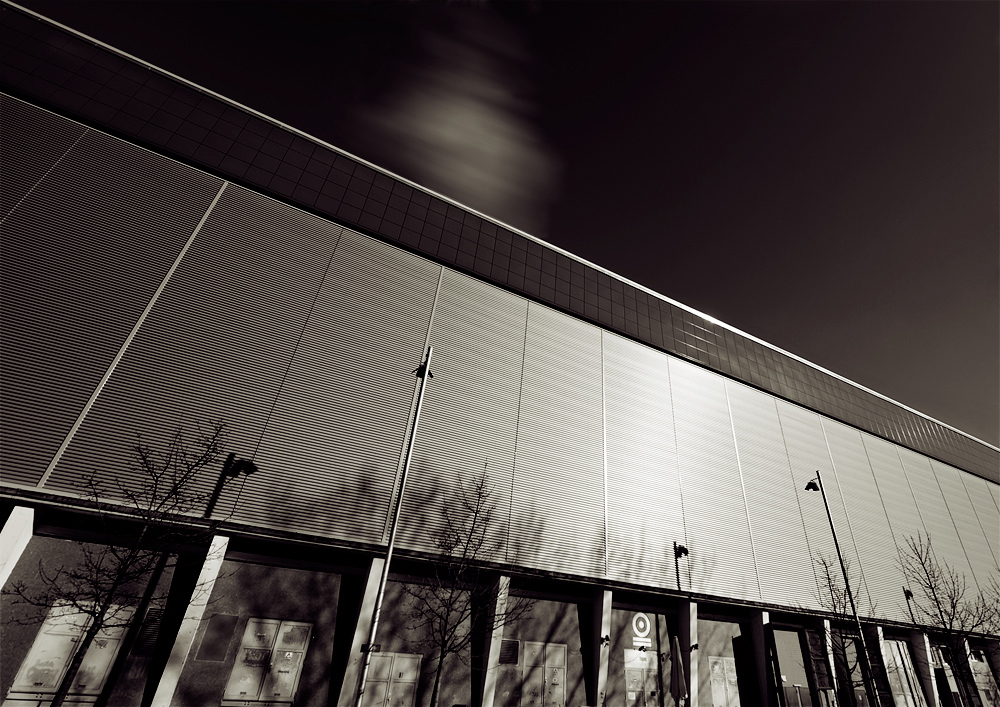
Our past
Tresor Club
In 1991, Tresor Clubs opened as Berlin’s first techno club in the vault of the former Wertheim department store on the former Berlin Wall strip. Tresor quickly became Berlin’s best-known techno club and gained worldwide fame. It became the platform for the international techno movement, which reached its peak in the 1990s with the rise of the Love Parade and its millions of visitors.
After protracted disputes over the preservation of the Tresor Club at its original location, the club had to leave the premises in Leipziger Strasse in 2005 and opened its new doors in the basement of the former Mitte power station in Köpenicker Strasse in 2007.
The Tresor Club is the oldest techno club in Berlin. It is an essential part of Berlin’s techno movement and, with the associated Tresor Records label, an important center of techno music and is still one of the most important clubs in Berlin today.

Exhibition poster of the Humboldt Forum
Tresor Records
At midnight on March 13, 1991, a cellar door opened at Leipziger Straße 126 in Berlin. Through this door walked many who were on their way to defining new territory in electronic music.
Tresor Records was founded in the same year and deepened connections beyond Germany. Up-and-coming musicians from Michigan, such as Juan Atkins, Underground Resistance and Drexciya, played a crucial role in these early years. Their visits to Berlin started the dialog between the youth movement in Europe and these musicians. This story is one of friendship, inextricably linked to cities like Detroit and Birmingham, where like-minded friends built something truly special, where insightful rhythms underpinned decaying industry in corrupted metropolises. This compilation marks 30 years of activity, from the luminaries of the early days to the current protagonists who have come together to continue to change our landscape. Each of them redefines this electronic sound as it twists and maneuvers around modern pressures and technological change.
From Detroit, we hear the magic of Juan Atkins reflecting the worn environments, to New York City and Speaker Music’s pertinent message of resistance. The breakneck electro of Helena Hauff deepens the path taken by Drexciya and Stingray. Moritz von Oswald’s expansive, synchronized constructions present an abstracted view of techno, an approach taken further by artists such as Donato Dozzy and Sophia Saze. These artists invoke ecstatic dizziness through sound, connecting you to the people around you and creating an atmosphere where our collective imagination becomes powerful.
For those who have danced and for those who will dance: The light at the end of the long vault tunnel is a signal. A flicker in the midst of the fog. This is our future. This is our place.

Tresor banners and safety deposit boxes from the old club room in the exhibition from the Vitra Design Museum's "Night Fever" exhibition
In the beginning was heat – The Kraftwerk Berlin
In 1961, the Berlin Kraftwerk Berlin was built parallel to the Berlin Wall. As the Berlin-Mitte combined heat and power plant, it supplied the eastern districts of Berlin with heat and electricity until 1997. In 2006, spatial researcher Dimitri Hegemann discovered the building and initially developed it for his club “Tresor”, which was looking for a new home. But Hegemann also immediately recognized the potential of the 100-metre-long turbine hall: a place that takes your breath away: steel, city, concrete, dust. An architecture that puts you in shackles and opens up a space that is unparalleled in its vastness – oppressive and liberating at the same time. And so the industrial cathedral was painstakingly and carefully converted and expanded to create a new cultural venue for Berlin. A place for collaborations between art, music, architecture and film and new forms of expression. Internationally renowned artists such as Ryoji Ikeda, Anne de Vries and Cyprien Gaillard have already shown their work here, ensembles such as the State Opera and the Rias Chamber Choir, choreographers such as Sharon Eyal and Florentina Holzinger have performed in the hall in recent years. The Berlin Atonal Festival takes place here once a year, attracting music enthusiasts from all over the world.
One of the foundation’s declared aims is to maintain and operate this space for cultural purposes in the long term through a hereditary leasehold.

The exterior of Kraftwerk Berlin
International projects
There has been a close friendship between Tresor Berlin and the Detroit techno scene since 1988. Without Detroit techno, the Berlin club scene as it exists today would not exist. In order to give something back to the city of Detroit and to maintain the “connection”, several initiatives have been founded. Here are a few examples:
➔ Website Underground Music Academy
Packard Automotive Plant
Detroit, MI, USA
The Packard Automotive Plant building complex, also completed by Albert Kahn Associates in 1903, offered itself as a location for further considerations regarding the construction of a cultural beacon in Detroit. The Packard Motor Car Company ceased operations in the factories there in 1958. It was used by various businesses until the end of the 1990s and was finally acquired at auction in 2013 by a Spanish investor who specialized in buying up and renovating industrial buildings in countries in North and South America. The complex consists of 28 buildings. Hegemann and his team developed a utilization concept for a single building on the site together with the Berlin-based Tresor architects from BüroZentral: The ruin was to be filled with individual cubes in which artists could live and work, as well as cultural and communal areas. Here, too, the original character of the building was to be preserved, while the new architecture was to be able to coexist with the ruins in a restrained and purposeful manner. Hegemann agreed to finance the renovations, the development of the team and the cultural program. Only the provision of a basic technical infrastructure and long-term planning security through the transfer of House 10 was requested from the investor of the site. As the direct, short-term profit of the concept was not high enough, the investor, who was initially very interested, unfortunately backed out.
Previous Episode
1982 – 1990
1982 Gründung des Atonal Festivals für progressive elektronische und experimentelle Musik- und Kunst durch Dimitri Hegemann, welches sich jährlich wiederholte.
1986 Gründung des FischBüros in der Wrangelstr. 70 in Kreuzberg. Als Galerie erdacht entwickelte sich das FischBüro schnell zu einem bekannten Dada Club im damaligen WestBerlin, der zu einer Keimzelle für eine Vielzahl von KünstlerInnen und Projekten wurde, die auch nach dem Mauerfall Furore machten. Die samstagabendlichen Forschungssitzungen zogen ein immer größeres Publikum an und sorgten für spektakuläre Aktionen im damaligen West Berlin. Nach dem Umzug 1987 in die Köpenicker Strasse wurden im Keller des dortigen FischBüros die ersten legendären UFO Parties veranstaltet, welche heute als Ursprungsort der Berliner Acid-House und Technoszene gelten.
1987 Eröffnung des Fischlabors, einer Szenekneipe in Berlin Schöneberg, die zu einem der Zentren der neuen Musikszene in West Berlin wurde.
Gründung des Plattenlabels Interfisch Records, das nach dem Mauerfall zum dem berühmten Label Tresor Records wurde, das Meilensteine der Technomusik veröffentlichte und namenhafte Stars der Technoszene förderte.

Fischbüro Flyer
1988 Eröffnung der Clubs UFO II in einem leestehenden Supermarkt in der Großgörschen Strasse in Berlin Schöneberg. Der UFO Club wurde zu einem der populärsten Clubs für die House und Acid und beginnenden Techno Bewegung und bereitete die nächste Revolution in der Musik- und Clubkultur in Berlin vor.
1989 Fall der Berliner Mauer
1988 – 1990 Reise Dimitri Hegmanns nach Chicago und Beginn der Zusammenarbeit dem Detroiter Projekt Final Cut/Jeff Mills, woraus eine bis heute Bestehende Freundschaft und Zusammenarbeit entwickelte. Dies begründet die bis heute anhaltende Verbindung Hegemanns mit der Stadt Detroit und der dortigen Artist und Musikszene.
1991 – 2006
1991 Eröffnung des Tresor Clubs als erster Techno Club Berlins in dem Tresorraum des ehemaligen Kaufhauses Wertheim. Der Tresor wurde schnell zum bekanntesten Technoclub Berlins und erlangte weltweiten Ruhm. Er avanciert zur Plattform für die internationale Techno Bewegung die mit dem Aufstieg der Loveparade mit einem Millionen Publikum in den 1990er Jahren ihren Höhepunkt erreichte.
Der Tresor Club ist der älteste Techno Club in Berlin. Er ist wesentlicher Bestandteil der Berliner Technobewegung und mit dem angeschlossenen Tresor Records Label bedeutendes Zentrum der Technomusik und zählt bis heute zu den wichtigsten Clubs in Berlin.
1995 Planung des Tresor Tower auf dem Gelände des Tresor Clubs in der Leipziger Strasse, um ein Technokulturzentrum mit Räumlichkeiten für Technoplattenlabels, -zeitschriften, – Modelabels, Restaurants und Hostels sowie weiteren Branchenbetrieben unter einem Dach zu vereinen. Leider konnte dieses wegweisende Projekt nicht verwirklicht werden.
2005 Nach langwierigen Streitigkeiten um den Erhalt des Tresor Clubs am Ursprungsort Auszug des Tresor Clubs aus den Räumlichkeiten in der Leipziger Strasse.
2007 – heute
2007 Eröffnung der neuen Räume des Tresor Clubs in dem ehemaligen Heizkraftwerk Mitte in der Köpenicker Strasse. Umwandlung der Industriekathedrale zu einem bedeutenden Kulturstandort in Berlin. Die ehemalige Turbinenhalle wurde aufwendig zu einem international renommierten Ausstellungs- und Veranstaltungsort ausgebaut.
2012 Gründung der Detroit Berlin Connection, die sich für den kulturellen Austausch beider Städte einsetzt. Schwerpunkt ist der Einfluss der Club- und Nachtkultur auf Stadtentwicklung
Gründung der Happy Locals, einer Beratungsagentur für junge Kreative und Gemeinden, die mit Know How Visionen und Projekte fördern will, um die Attraktivität von Regionen und kleineren Gemeinden in strukturschwachen Gebieten zu steigern.
2013 Wiederbelebung des Berlin Atonal Festivals unter neuer Führung. Seit der Neuauflage des Festivals hat es sich zu einem bedeutenden Festival für avantgardistische und experimentelle moderne und elektronische Musik und Künste entwickelt.
2021 Vorstellung Inititaive Clubs für Deutschland auf dem deutschen Städtetag. Die Initiative hat es sich zum Ziel gesetzt, die Clubkultur in Deutschland zu verbreiten und damit einen Beitrag zur Aufwertung von strukturschwachen Regionen und die Abwanderung junger talentierter Menschen aus diesen zu stoppen.
Gründung der Stiftung Tresor Foundation Berlin, deren Zweck in der Bewahrung des Lebenswerkes von Dimitri Hegemann und der Förderung von Kunst und Kultur bestehen.
2022 31 Jahre Tresor Club, Ausstellung Techno, Berlin und die große Freiheit, die die Geschichte des Tresor Clubs und der Berliner Technobewegung beinhaltet
2023 Gründung der Academy for Subcultural Understanding. Ziel der Academy ist es, jungen Menschen aus ganz Deutschland das Wissen und die Erfahrung für den Aufbau und erfolgreichen Betrieb eigener Clubprojekte zu vermitteln
2024 im Frühjahr Beginn der Arbeit der Academy mit der ersten Ausbildungsrunde
Anerkennung der Berliner Clubkultur als immaterielles Kulturerbe Deutschlands durch die UNESCO
Nach der Übersiedlung des renommierten Techno Plattenladens Hard Wax und der Aufnahme der Arbeit der Academy ist Hegemann seinem Ziel eines Technokulturzentrums auf dem Areal des Kraftwerks Berlin näher gekommen.
Für die Zukunft bestehen der Plan und die Aufgabe, diesen Ort als Kulturstandort und Kreativzentrum in Berlin zu erhalten und auszubauen.
